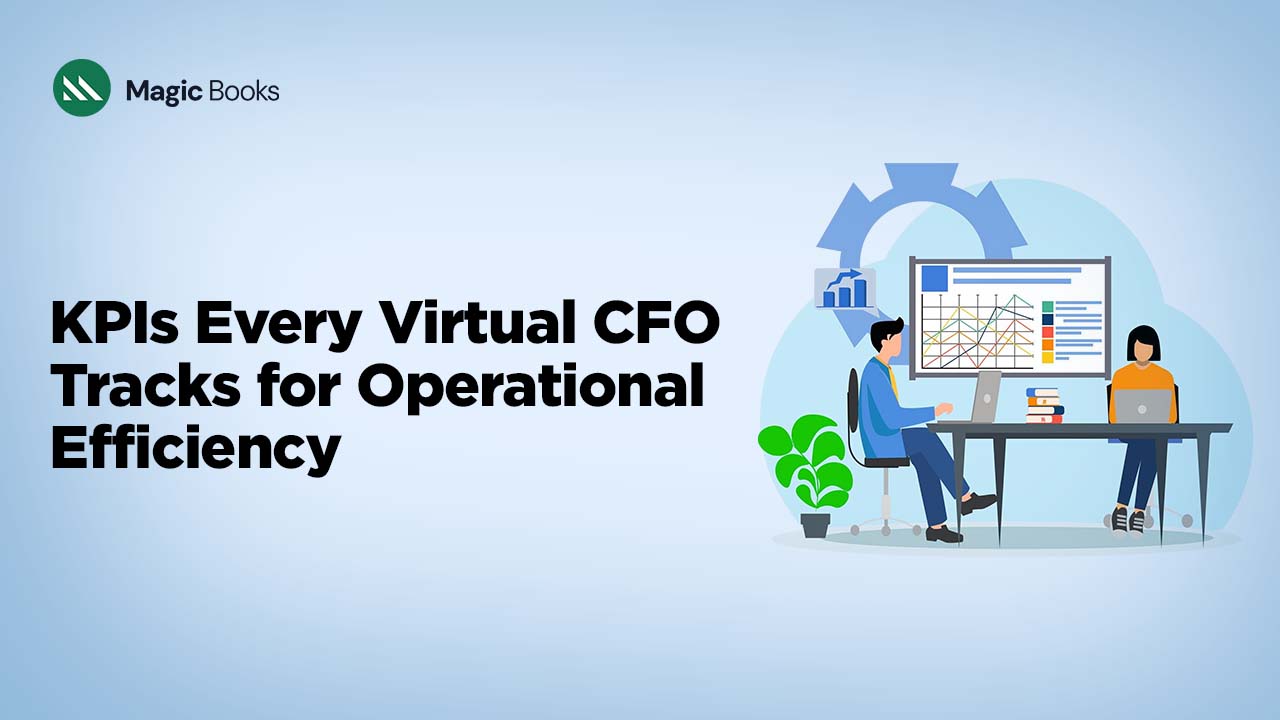The finance and accounting outsourcing market was valued at USD 54.79 billion in 2025 and is projected to reach USD 81.25 billion by 2030. That’s substantial growth. It points to something important: businesses are rethinking how they handle financial operations. Virtual CFOs have become go-to partners for companies that want better control over cash flow, margins, and planning cycles without the overhead of a full-time executive. When every dollar matters, knowing which metrics to track makes the difference between staying ahead and constantly reacting to problems.
What a Virtual CFO Does
A Virtual CFO is a senior financial executive who works with clients part-time or on specific projects rather than joining the payroll full-time. What sets them apart is their focus on measuring and improving operational efficiency. Better metrics mean faster decisions, healthier cash positions, and outcomes you can actually predict. Deloitte’s CFO Signals survey found that more than half of executives now outsource at least one finance function. They want specialized expertise and real-time visibility into what’s actually happening in the business.
Why KPIs Matter for Operational Efficiency
Operational KPIs let you act before things go sideways. When your finance team consistently tracks cash runway, margin trends, and where you’re hitting or missing budget, you can adjust pricing, renegotiate with suppliers, or speed up collections before liquidity becomes a real issue. The Federal Reserve’s Small Business Credit Survey shows that a lot of firms simply don’t have the financial cushion to weather extended revenue drops. That makes proactive KPI monitoring a survival tool. Real-time data transforms finance from just recording what happened into helping you figure out what to do next.
Core KPIs Every Virtual CFO Tracks
Cash Flow Forecast Accuracy
This one measures how closely your predicted cash movements line up with what actually shows up in the bank. Virtual CFOs calculate it by comparing the forecasted cash position to the ending balance. Then they divide the difference by the forecast to get a variance percentage. Most review this weekly or every other week. They pull data straight from bank feeds and the cash receipts and disbursements modules in the accounting system. High forecast accuracy means you can confidently make calls about hiring, buying inventory, or spending on capital projects.
Operating Cash Runway
Operating cash runway tells you how many months you can keep the lights on at your current burn rate before the money runs out. The math is simple. Take cash on hand and divide it by the monthly net cash outflow. You get a number expressed in months. Virtual CFOs recalculate this at least monthly, and often weekly if the company is growing fast or going through a restructuring. Knowing your runway protects operations because it triggers conversations about fundraising, expense cuts, or revenue pushes well before you’re staring at an empty account.
Days Sales Outstanding
Days Sales Outstanding (DSO) tracks how long it takes, on average, to collect payment after you make a sale. The calculation divides accounts receivable by average daily sales. That’s annual revenue divided by 365. Most vCFOs measure this monthly so they can spot any slowdowns in collections that tie up working capital. Lower DSO means cash comes in faster. You need less external financing, and your credit management and invoicing processes are working.
Days Payable Outstanding
Days Payable Outstanding measures how long your company takes to pay suppliers. Virtual CFOs calculate DPO by dividing accounts payable by the average daily cost of goods sold. Tracking it monthly helps you balance keeping cash in the business with maintaining good supplier relationships. Stretch payables too far and you risk damaging terms or supply reliability. Get it right, though, and you preserve cash without burning bridges.
Working Capital Ratio
The Working Capital Ratio (also called the Current Ratio) divides current assets by current liabilities. It signals whether you have enough short-term resources to cover what’s due in the next twelve months. Virtual CFOs look at this monthly or quarterly. It depends on how fast receivables, inventory, and payables are changing. A ratio under 1.0 is a red flag for liquidity trouble. Way above 2.0 might mean you’re sitting on capital that could be put to better use.
Gross Margin Percentage by Product or Service Line
Gross margin percentage shows profitability after direct costs. Take revenue minus cost of goods sold, then divide by revenue. Virtual CFOs break this down by product line or service and review it monthly to catch margin erosion early. Data usually comes from the revenue and COGS modules in the accounting system. Sometimes it’s backed up by job-costing or project-tracking tools. This visibility drives decisions about pricing, vendor negotiations, and which offerings you should expand or phase out.
EBITDA Margin
EBITDA margin takes out interest, taxes, depreciation, and amortization to show operational profitability as a percentage of revenue. Virtual CFOs calculate this monthly or quarterly. It’s earnings before those non-cash and financing items, divided by total revenue. It gives you a clearer picture of operating performance than net income alone, especially when you’re comparing companies with different capital structures or tax situations. Tracking EBITDA margin trends helps vCFOs see whether operational improvements are sticking or if cost pressures are outpacing revenue gains.
Budget Versus Actual Variance
Budget versus actual variance compares what you planned to spend or earn against what actually happened. Virtual CFOs express this as both dollar differences and percentages. They track variance across all major line items every month. Anything that swings more than a set threshold (usually around 10 percent) gets flagged. When variance persists, it signals operational trouble. Could be uncontrolled expenses, missed sales targets, or outdated budget assumptions. Quick variance analysis lets leadership course-correct mid-period instead of finding out about problems when the year’s already over.
Burn Rate
Burn rate is your net cash outflow per month. Calculate it by subtracting cash receipts from cash payments over 30 days. Startups and growth-stage companies measure this weekly. More mature firms might review it monthly. When burn accelerates unexpectedly, it triggers immediate changes. Hiring freezes, marketing budget cuts, urgent talks with investors or lenders. Real-time burn rate visibility prevents cash crises and keeps the leadership team on the same page about spending priorities.
Forecast Versus Actual Gross Profit Trend
This is a forward-looking KPI that compares projected gross profit to what you actually delivered over rolling periods, typically quarters. Virtual CFOs track it by plotting both the forecast and actual lines on the same chart. Then they dig into any widening gap. It matters because gross profit funds your operating expenses. Consistent misses point to pricing problems, cost overruns, or demand shifts that need strategic fixes. Monitoring gross profit trends helps vCFOs refine future forecasts and recommend timely operational tweaks.
Data Sources and Tools
Most KPIs pull from a mix of accounting systems, bank feeds, ERP or payroll exports, and AR/AP ledgers. Cloud-based platforms have made real-time data access pretty routine, even for small and mid-sized firms. According to Intuit’s 2024 Business Solutions Survey, companies that integrate their financial tools save about 25 hours per week on manual data entry and reconciliation. That speeds up KPI reporting and improves accuracy. FP&A tools and dashboard software sit on top of core accounting data. They automate variance calculations, trend charts, and executive summaries.
How a Virtual CFO Uses KPIs to Improve Operational Efficiency
Virtual CFOs follow a structured decision loop. They monitor the KPI dashboard, diagnose any variance or warning sign, prescribe a specific operational fix, and then track the outcome to make sure it worked. This cycle is what turns numbers into action. Maybe that’s accelerating invoicing to improve DSO, renegotiating supplier terms to extend DPO, or cutting discretionary spending to protect runway. Without disciplined tracking, adjustments happen too late or miss the root cause entirely.
Effective vCFOs also establish a reporting cadence that matches how the business actually operates. Weekly reviews focus on cash position and burn rate. Monthly reviews cover the full KPI suite, including margin and variance analysis. Quarterly sessions dive into strategic metrics like EBITDA trends and forecast accuracy over longer stretches. Deloitte’s CFO surveys consistently show that finance leaders who maintain regular KPI review cycles feel more confident about meeting performance targets and adapting when markets shift.
Common Reporting Format and Communication Tips for the Leadership Team
Virtual CFOs usually recommend a concise dashboard format. Put three to five leading indicators on the first page, with supporting detail on subsequent tabs or pages. Each number should come with a single-sentence interpretation so non-finance executives understand whether the trend is good, neutral, or needs action. Plain language and visual cues (think red-yellow-green status indicators) make KPI reports accessible to the whole leadership team and speed up decision-making.
Conclusion
Tracking the KPIs outlined above helps maintain operational efficiency by turning financial data into early warnings and actionable insights. When virtual CFOs consistently measure cash runway, DSO, gross margin, burn rate, and variance, businesses get the visibility they need to reduce surprises and navigate uncertainty with confidence. For further reading on integrated financial solutions and automation tools that support KPI tracking, visit MagicBooks to explore how modern platforms streamline bookkeeping and reporting for growing businesses.


